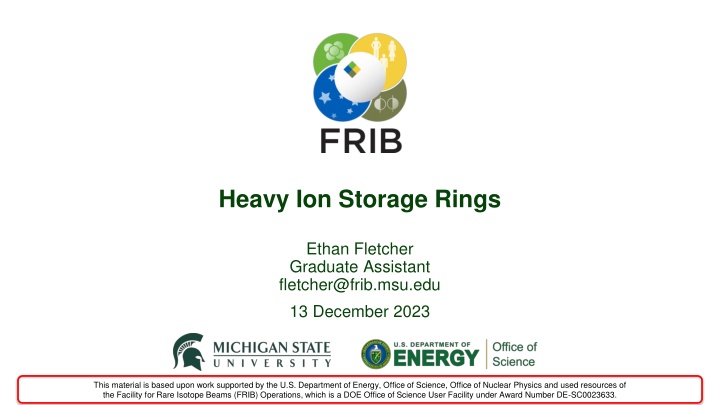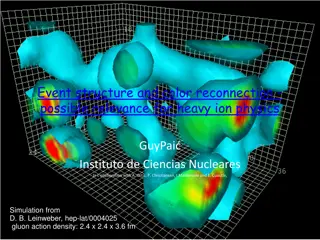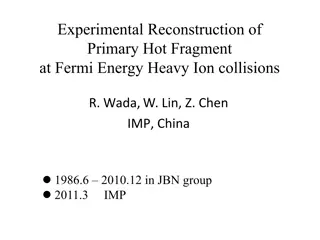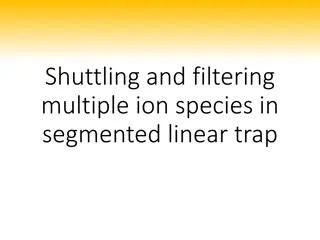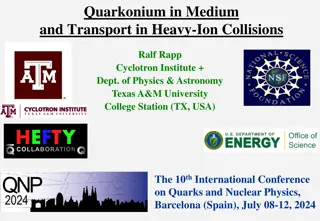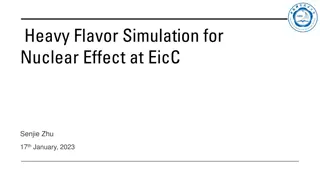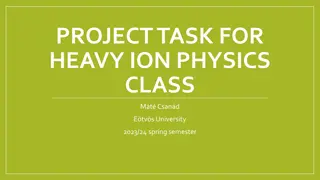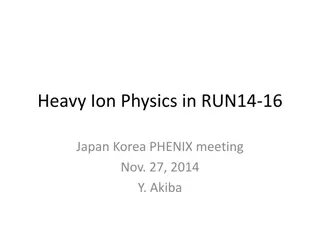Advancing Nuclear Physics with Heavy Ion Storage Rings
Explore the world of rare isotopes and exotic ions through the use of Heavy Ion Storage Rings, enabling precision measurements, production of unstable nuclei, and beam-target interactions for studying nuclear processes and astrophysical relevance. Supported by the U.S. Department of Energy, this technology opens new doors in nuclear physics research.
Download Presentation

Please find below an Image/Link to download the presentation.
The content on the website is provided AS IS for your information and personal use only. It may not be sold, licensed, or shared on other websites without obtaining consent from the author.If you encounter any issues during the download, it is possible that the publisher has removed the file from their server.
You are allowed to download the files provided on this website for personal or commercial use, subject to the condition that they are used lawfully. All files are the property of their respective owners.
The content on the website is provided AS IS for your information and personal use only. It may not be sold, licensed, or shared on other websites without obtaining consent from the author.
E N D
Presentation Transcript
Heavy Ion Storage Rings Ethan Fletcher Graduate Assistant fletcher@frib.msu.edu 13 December 2023 This material is based upon work supported by the U.S. Department of Energy, Office of Science, Office of Nuclear Physics and used resources of the Facility for Rare Isotope Beams (FRIB) Operations, which is a DOE Office of Science User Facility under Award Number DE-SC0023633.
The Problem Want to study rare isotopes and exotic ions 1. Expand our understanding of nuclear structure and processes 2. Relevance to astrophysics- extreme processes that create elements Difficulties Lifetimes of these isotopes/ions can be very short Require large energies to create Energies and environment required for creation of ions/isotopes can be recreated in an accelerator Producing rare nuclides and ion states requires dedicated facilities separate from the primary beam line Facility for Rare Isotope Beams U.S. Department of Energy Office of Science | Michigan State University 640 South Shaw Lane East Lansing, MI 48824, USA frib.msu.edu E. Fletcher, 13 December 2023, Slide 2
The Solution- Heavy Ion Storage Rings Store and accumulate ions at very high currents Stable ions and exotic, unstable nuclides Allows for precision measurements of unstable nuclei Rare isotopes/ions produced via interaction with some sort of target For charged ions, sent through a charge stripper For other nuclei of interest, interaction with target removes nucleons High probability of neutron deficient nuclei In-flight fission reaction using 238 U produces more neutron rich nuclei RARE-RI ring at RIKEN Facility for Rare Isotope Beams U.S. Department of Energy Office of Science | Michigan State University 640 South Shaw Lane East Lansing, MI 48824, USA frib.msu.edu E. Fletcher, 13 December 2023, Slide 3
Beam-Target interactions All reactions, atomic and nuclear, will be accompanied by contaminants For highly charged ions, these are ions of the same element, but in a different charge state For rare nuclides, there is a distribution of different nuclei produced which require in-flight separation How do we isolate beams of interest? For highly charged ions, use a dipole magnet After stripping, ions travel with similar velocities and energy -> angular straggling is small Rare nuclides require dedicated separator facilities The B - E-B method: Use energy degraders, analyze rigidity before/after degrader May lead to phase space enlargement of the beams CRYRING at ESR Facility for Rare Isotope Beams U.S. Department of Energy Office of Science | Michigan State University 640 South Shaw Lane East Lansing, MI 48824, USA frib.msu.edu E. Fletcher, 13 December 2023, Slide 4
Experiments at heavy ion storage rings- Storage Ring Mass Spectometry Interplay of strong, weak, and EM interactions complicate measurements Connection to mass demonstrated through binding energy Need precision mass measurements of exotic nuclei Measured by relative mass accuracy, Charge-Mass ratios are directly related to revolution frequency Second term uses velocity spread which determines mass resolving power Must minimize Schottky Mass Spectometry Isochronous Mass Spectrometry Facility for Rare Isotope Beams U.S. Department of Energy Office of Science | Michigan State University 640 South Shaw Lane East Lansing, MI 48824, USA frib.msu.edu E. Fletcher, 13 December 2023, Slide 5
Schottky Mass Spectometry Utilizes beam cooling using electrons and/or stochastic cooling High emittance of secondary beam causes large velocity spread Allows simultaneous injection and storage of multiple ion species with varying M/Q but similar v This allows for matching of magnetic rigidity to that of the selected injection B of the ring Analyze the revolution frequencies with well-known and unknown masses Advantage: High sensitivity to single stored ions with on the order of 10-7 Disadvantage: Relatively long time period for cooling ~1 s Longer than some nuclei lifetime Facility for Rare Isotope Beams U.S. Department of Energy Office of Science | Michigan State University 640 South Shaw Lane East Lansing, MI 48824, USA frib.msu.edu E. Fletcher, 13 December 2023, Slide 6
Isochronous Mass Spectrometry Used at the RARE-RI Ring at RIKEN Ions of interest injected with energies corresponding to transition energy The idea: The faster ion of a particular ion species travels on a longer orbit than a slower ion of similar species Thus, the velocity spread of the ions is compensated by the lengths of their respective orbits Therefore, the term is eliminated to first order Revolution frequencies are similar and only depend on M/Q Measured by TOF detectors Facility for Rare Isotope Beams U.S. Department of Energy Office of Science | Michigan State University 640 South Shaw Lane East Lansing, MI 48824, USA frib.msu.edu E. Fletcher, 13 December 2023, Slide 7
Additional capabilities Used to test fundamental interactions and probe symmetries Investigate nuclear reactions at various beam energies from low to high Analyze several-body decays of highly charged ions Probe hyperfine structure Nuclear lifetime spectroscopy Measurement of decay rates Precision testing of bound-state quantum electrodynamics Study of hydrogen like ions in very strong EM fields In short, heavy ion storage rings have, currently are, and will continue to prove extremely useful in unlocking the secrets of atomic nuclear physics Facility for Rare Isotope Beams U.S. Department of Energy Office of Science | Michigan State University 640 South Shaw Lane East Lansing, MI 48824, USA frib.msu.edu E. Fletcher, 13 December 2023, Slide 8
References M. Steck, Y.A. Litvinov, Heavy-ion storage rings and their use in precision experiments with highly charged ions, Prog Part Nucl Phys, 115 (2020), Article 103811 Y. Yamaguchi, Y. Abe, The rare-ri ring at riken RI beam factory, Proceedings of HIAT 2015, Yokohama, Japan, https://accelconf.web.cern.ch/HIAT2015/papers/tum1c03.pdf P. Butler, K. Blaum, T. Davinson, K. Flanagan, S. Freeman, M. Grieser, I. Lazarus, Y. Litvinov, G. Lotay, R. Page, R. Raabe, E. Siesling, F. Wenander, P. Woods, TSR: A storage and cooling ring for HIE-ISOLDE, Nucl. Instrum. Methods Phys. Res. B 376 (2016) 270 274, http://dx.doi.org/10.1016/j.nimb.2015.12.006 https://www.nndc.bnl.gov/nudat3/ Facility for Rare Isotope Beams U.S. Department of Energy Office of Science | Michigan State University 640 South Shaw Lane East Lansing, MI 48824, USA frib.msu.edu E. Fletcher, 13 December 2023, Slide 9
